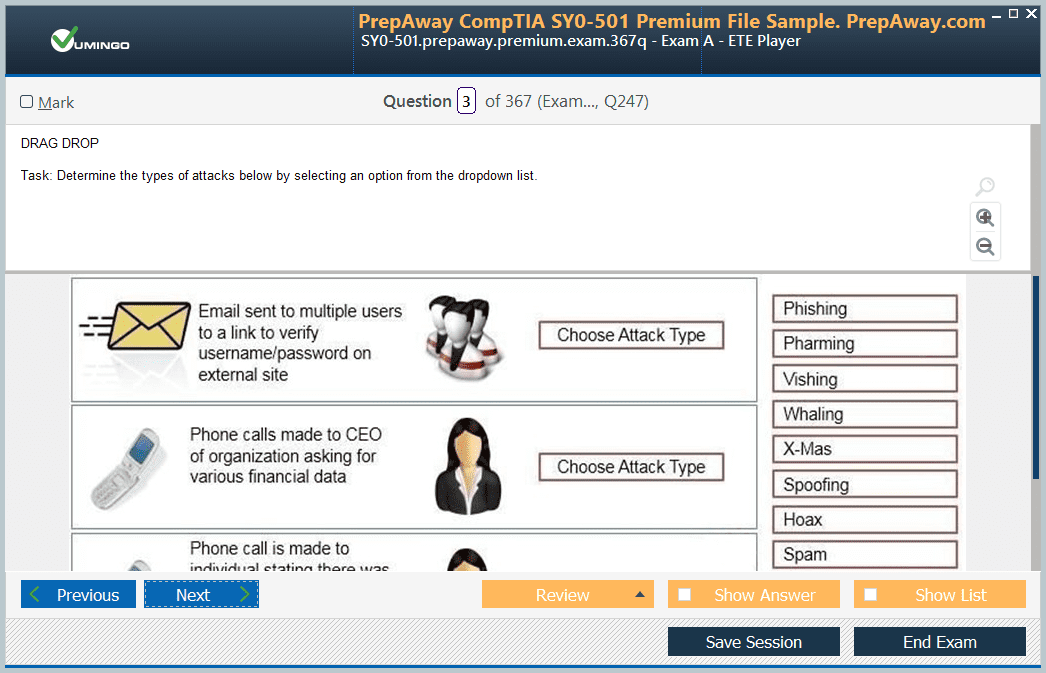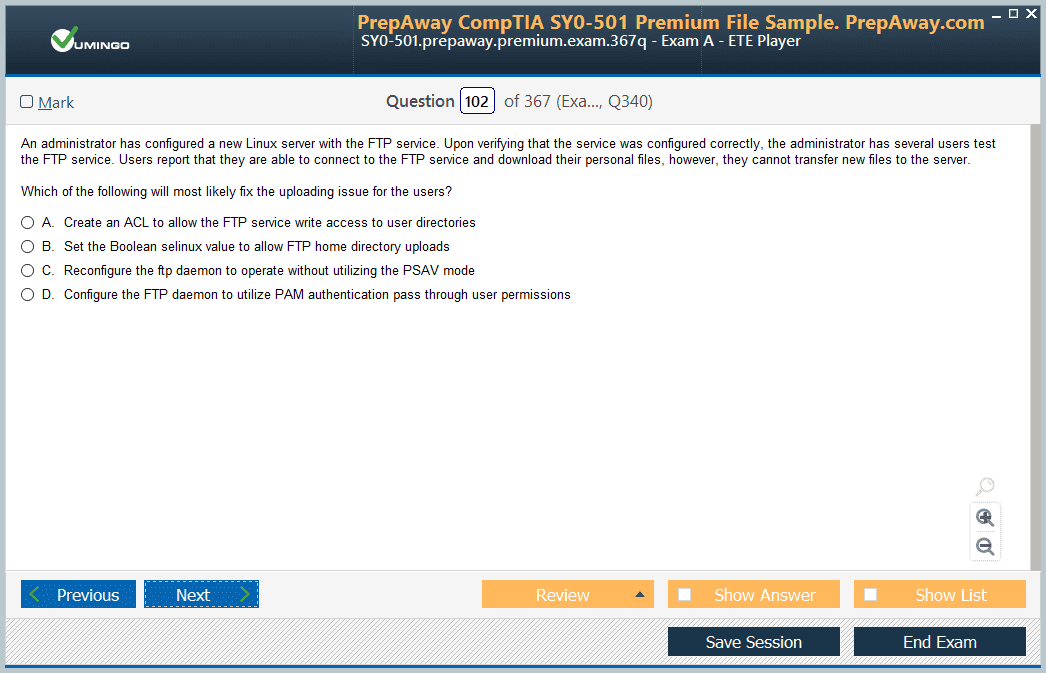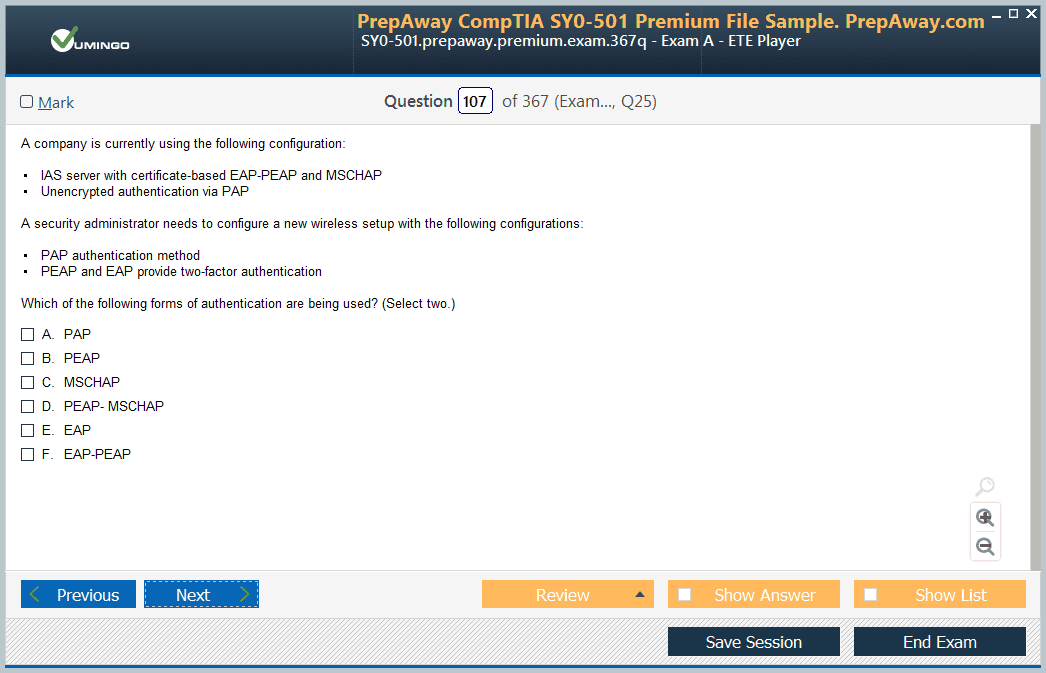- Home
- Microsoft Certifications
- DP-600 Implementing Analytics Solutions Using Microsoft Fabric Dumps
Pass Microsoft DP-600 Exam in First Attempt Guaranteed!
Get 100% Latest Exam Questions, Accurate & Verified Answers to Pass the Actual Exam!
30 Days Free Updates, Instant Download!


DP-600 Premium Bundle
- Premium File 198 Questions & Answers. Last update: Nov 28, 2025
- Training Course 69 Video Lectures
- Study Guide 506 Pages
Last Week Results!

Includes question types found on the actual exam such as drag and drop, simulation, type-in and fill-in-the-blank.

Based on real-life scenarios similar to those encountered in the exam, allowing you to learn by working with real equipment.

Developed by IT experts who have passed the exam in the past. Covers in-depth knowledge required for exam preparation.
All Microsoft DP-600 certification exam dumps, study guide, training courses are Prepared by industry experts. PrepAway's ETE files povide the DP-600 Implementing Analytics Solutions Using Microsoft Fabric practice test questions and answers & exam dumps, study guide and training courses help you study and pass hassle-free!
Mastering Microsoft Fabric: DP-600 Certification Study Guide
The DP-600 exam, Implementing Analytics Solutions Using Microsoft Fabric, is designed for professionals who aim to demonstrate expertise in designing, developing, and deploying enterprise-level analytics solutions. This exam tests a candidate’s ability to leverage Microsoft Fabric components to transform raw data into meaningful insights. It also evaluates skills in data modeling, data transformation, analytics best practices, and deployment processes. For individuals pursuing a career as a Microsoft Fabric analytics engineer, this certification validates the ability to manage end-to-end analytics solutions efficiently and effectively.
Microsoft Fabric integrates various analytics capabilities into a single ecosystem. It offers tools such as Lakehouses, Data Warehouses, Dataflows, Notebooks, Pipelines, Semantic Models, and Reports, all of which play a critical role in preparing and analyzing data. DP-600 focuses on the practical application of these tools to ensure optimal performance, governance, and deployment of analytics solutions.
Overview of DP-600 Exam Domains
The DP-600 exam is divided into four main domains. Each domain measures specific skills required to implement analytics solutions using Microsoft Fabric. These domains and their approximate weightings are:
Plan, Implement, and Manage a Solution for Data Analytics: 10–15%
Prepare and Serve Data: 40–45%
Implement and Manage Semantic Models: 20–25%
Explore and Analyze Data: 20–25%
Each domain contains specific topics and skill sets that candidates must master. By understanding the domain structure, candidates can prioritize their study efforts and ensure they cover all essential concepts.
Plan, Implement, and Manage a Solution for Data Analytics
This domain focuses on planning and managing data analytics solutions within Microsoft Fabric. A solid understanding of Microsoft Fabric administration is required, including setting up environments, managing capacities, and implementing governance. Candidates must also be familiar with the analytics development lifecycle, which encompasses creating projects, managing deployment pipelines, and integrating version control systems such as Git.
Setting up Microsoft Fabric environments involves creating workspaces, defining capacities, and managing access control. Analytics engineers need to ensure that environments are secure, scalable, and optimized for performance. This includes configuring resources efficiently, monitoring system health, and applying best practices for governance and compliance.
Deployment pipelines are an integral part of the development lifecycle. Candidates must understand how to configure YAML pipelines, implement CI/CD workflows, and manage Power BI projects within Microsoft Fabric. Knowledge of deployment processes ensures that analytics solutions can be reliably promoted from development to production environments. Additionally, integrating Git for source control helps maintain version history, enables collaborative development, and allows for rollback in case of errors.
Understanding analytics best practices is also critical in this domain. Engineers must be capable of designing solutions that are maintainable, reusable, and scalable. This involves modular design of dataflows, semantic models, and reports. Proper documentation and adherence to governance policies ensure that solutions meet enterprise standards and can be efficiently maintained over time.
Microsoft Fabric Components Overview
To implement analytics solutions effectively, it is essential to understand the components of Microsoft Fabric. Lakehouses combine the capabilities of data lakes and data warehouses, allowing for the storage and querying of structured and unstructured data. Data Warehouses provide a structured environment for large-scale data storage and optimized querying. Dataflows enable the transformation and preparation of data for analytics, while Notebooks allow for exploratory analysis using scripts and visualizations.
Pipelines automate data movement, transformation, and processing. Semantic Models provide an abstraction layer for reporting tools, enabling efficient data access and analysis. Reports, often created using Power BI, visualize data and provide actionable insights to decision-makers. Each component serves a specific purpose, and understanding their roles and interactions is essential for building robust analytics solutions.
Prepare and Serve Data
This domain carries the largest weight in the DP-600 exam and focuses on preparing and delivering data in a manner suitable for analytics. Candidates must be proficient in data ingestion, transformation, and optimization within Microsoft Fabric. This includes knowledge of dataflows, notebooks, and pipelines.
Dataflows are used to clean, transform, and enrich data before it is used in analytical models. Understanding dataflow configuration, transformation functions, and optimization techniques is critical for ensuring high performance. Engineers must also be adept at managing data quality and consistency, as these factors directly affect the accuracy of analytics results.
Notebooks allow for interactive exploration of datasets using scripting languages and visualization tools. Candidates should be able to create, execute, and share notebooks effectively. They should also understand how to integrate notebooks with other Microsoft Fabric components for seamless data processing.
Pipelines automate the movement and transformation of data across the analytics ecosystem. Knowledge of pipeline creation, scheduling, error handling, and performance optimization is necessary for ensuring timely and reliable data delivery. Candidates must also understand how to monitor pipelines and troubleshoot issues to maintain smooth operations.
Optimizing data for performance involves techniques such as partitioning, indexing, caching, and query tuning. Candidates should be able to identify performance bottlenecks and implement strategies to enhance data processing efficiency. This ensures that analytics solutions deliver results quickly and accurately, even with large datasets.
Data Governance and Security
An essential aspect of preparing and serving data is maintaining proper governance and security. Candidates must understand access control, role-based security, and data classification. Implementing security measures such as encryption, auditing, and monitoring ensures that sensitive data is protected from unauthorized access and potential breaches.
Data governance policies define standards for data quality, consistency, and usage. Engineers should be capable of implementing these policies to maintain trustworthiness and compliance. Understanding regulatory requirements and industry standards is also important for enterprise-level analytics solutions.
Integration with External Data Sources
In addition to internal Microsoft Fabric components, candidates should be familiar with integrating external data sources. This includes connecting to databases, cloud storage, APIs, and other enterprise systems. Data ingestion from multiple sources requires understanding data formats, protocols, and transformation requirements.
Efficient integration ensures that analytics solutions have access to all relevant data. Candidates must also be aware of performance implications and best practices for managing external connections, such as incremental data loading, error handling, and retry mechanisms.
Implement and Manage Semantic Models
Semantic models are a foundational component of Microsoft Fabric analytics solutions. They provide an abstraction layer that enables end users and business analysts to interact with complex datasets without requiring deep knowledge of underlying data structures. A semantic model organizes data into tables, relationships, measures, and calculations, offering a consistent and optimized environment for reporting and analysis. In the DP-600 exam, candidates are expected to design, implement, and manage semantic models effectively to deliver high-performance analytical solutions.
Understanding Semantic Models in Microsoft Fabric
Semantic models in Microsoft Fabric provide a structured representation of data that supports querying, visualization, and analytical workflows. These models enable efficient access to large datasets, reduce complexity, and enhance performance. A well-designed semantic model ensures consistency across reports and dashboards, allowing business users to make informed decisions based on reliable data.
Semantic models can be implemented using various Microsoft Fabric components, including Power BI datasets, Direct Lake mode, and other analytical services. Direct Lake mode is a key feature that allows real-time querying of data stored in Lakehouses without moving it into a dedicated dataset. This mode improves performance and enables up-to-date analytics by leveraging the underlying storage directly.
Understanding the differences between traditional Power BI datasets and Direct Lake mode is crucial. While datasets require data to be imported and processed, Direct Lake mode allows queries to access data in its original storage location. Candidates should be familiar with scenarios where each approach is appropriate, balancing performance, data freshness, and scalability.
Designing Semantic Models
Designing a semantic model involves defining tables, relationships, measures, and hierarchies to meet analytical requirements. The process begins with analyzing the business scenario, understanding data sources, and identifying key metrics and dimensions. Proper planning ensures that the model supports both current and future reporting needs.
Tables in a semantic model represent the underlying data. Each table may contain columns representing attributes or metrics. Relationships between tables define how data is connected, enabling users to navigate across different datasets seamlessly. Candidates must understand cardinality, cross-filter direction, and relationship types to ensure accurate aggregation and calculation.
Measures are calculations applied to data, such as sums, averages, ratios, or custom calculations using Data Analysis Expressions (DAX). Creating efficient measures requires understanding the performance implications of complex calculations and optimizing DAX expressions. Hierarchies allow users to drill down into data across multiple levels, such as year, quarter, and month, providing flexibility in analysis.
Normalization and denormalization are important design considerations. While normalized models reduce redundancy, denormalized models often improve query performance and simplify reporting. Candidates must balance these considerations to achieve both accuracy and efficiency.
Implementing Semantic Models
Implementation involves translating the design into an operational model within Microsoft Fabric. Candidates should be proficient in using tools like Power BI Desktop, Notebooks, and Dataflows to build semantic models. Dataflows can be used to transform raw data into structured tables, while Power BI Desktop allows the creation of relationships, measures, and visual hierarchies.
Direct Lake mode configuration is a critical implementation step. This involves connecting to Lakehouse storage, defining tables, and enabling query capabilities. Understanding how to configure security, optimize query performance, and manage metadata is essential for leveraging this mode effectively.
Incremental refresh and partitioning strategies improve performance for large datasets. Incremental refresh reduces processing time by updating only new or modified data. Partitioning divides tables into manageable segments, allowing parallel processing and faster query execution. Candidates should be able to configure these strategies to optimize model performance.
Version control and deployment are also key aspects of implementation. Using Git integration, candidates can manage changes to semantic models, track history, and collaborate with team members. Deployment pipelines ensure that models are consistently promoted from development to test and production environments.
Managing Semantic Models
Managing semantic models involves maintaining their accuracy, performance, and usability over time. Regular monitoring of usage patterns, query performance, and data quality is essential. Microsoft Fabric provides tools for auditing and analyzing model performance, allowing engineers to identify bottlenecks and optimize calculations.
Security management is another critical responsibility. Role-based access control ensures that users can access only authorized data. Implementing row-level security enables fine-grained control over data visibility based on user roles. Candidates must be familiar with configuring security settings to comply with organizational policies and regulatory requirements.
Metadata management ensures that semantic models remain understandable and maintainable. Clear naming conventions, documentation, and consistent structures allow new team members to navigate and use the model effectively. Good metadata practices also support automated deployment and integration with reporting tools.
Updating models to reflect changing business requirements is a common task. This may involve adding new tables, updating relationships, modifying measures, or implementing additional hierarchies. Candidates must be able to implement these changes without disrupting existing analytics workflows.
Optimizing Semantic Models
Optimization ensures that semantic models provide fast, responsive queries and scalable analytics. Efficient data modeling, proper indexing, and query optimization techniques are essential. Candidates should understand techniques such as aggregations, calculated columns, and optimized DAX expressions to enhance performance.
Aggregations summarize detailed data, reducing query time and improving responsiveness. Calculated columns can simplify analysis, but may impact performance if overused. Measures are preferred for dynamic calculations because they are evaluated at query time and can leverage optimized storage engines.
Query performance can be monitored using Microsoft Fabric tools, which provide insights into execution time, resource usage, and query bottlenecks. Candidates should be able to interpret these metrics and apply optimization techniques, such as rewriting DAX expressions, reducing row-level calculations, and implementing caching strategies.
Advanced Features of Semantic Models
Semantic models support advanced features such as composite models, calculation groups, and AI integration. Composite models allow combining imported data with Direct Lake or other live connections, providing flexibility in analytics scenarios. Calculation groups simplify the management of repetitive measures and time-based calculations.
Integration with AI services enables predictive analytics, anomaly detection, and machine learning workflows. Candidates should understand how to incorporate these features into semantic models to deliver advanced insights. Implementing AI-driven analytics requires knowledge of model design, data preparation, and deployment strategies.
Best Practices for Semantic Models
Following best practices ensures that semantic models are maintainable, scalable, and performant. Key practices include clear documentation, consistent naming conventions, modular design, and proper version control. Candidates should also focus on user experience, ensuring that models are intuitive, easy to navigate, and aligned with business requirements.
Testing and validation are essential to ensure model accuracy. This includes verifying relationships, calculations, hierarchies, and security configurations. Automated testing can be implemented to validate changes and maintain model integrity.
Collaboration with business stakeholders is important for understanding requirements and ensuring that semantic models meet analytical needs. Regular feedback loops help identify improvements and refine models over time.
Monitoring and Maintenance
Ongoing monitoring and maintenance are critical for long-term success. Performance monitoring involves tracking query response times, resource utilization, and user activity. Data quality monitoring ensures that inputs are accurate, consistent, and reliable. Regular updates and optimizations help maintain high performance and usability.
Change management processes should be implemented to track modifications, evaluate impacts, and communicate changes to stakeholders. Maintaining a balance between agility and stability is important for managing semantic models in a dynamic business environment.
Explore and Analyze Data in Microsoft Fabric
Exploring and analyzing data is a critical domain in the DP-600 exam. This domain focuses on querying, investigating, and deriving insights from data using Microsoft Fabric components. The ability to analyze data effectively allows analytics engineers to provide actionable intelligence, support decision-making, and enhance business outcomes. In this domain, candidates are expected to be proficient in querying tools, data exploration techniques, and analysis strategies that leverage the capabilities of Microsoft Fabric.
Understanding the Data Exploration Process
Data exploration is the process of examining datasets to identify patterns, anomalies, trends, and relationships. It serves as the foundation for data analysis, helping analysts understand the structure and content of data before performing more complex modeling or reporting tasks. In Microsoft Fabric, exploration involves querying Lakehouses, Data Warehouses, and other storage elements to inspect raw or transformed data.
The exploration process begins with data profiling, which includes reviewing data types, distributions, missing values, and outliers. Understanding data quality is essential for ensuring accurate analysis. Candidates should be familiar with tools like Notebooks, SQL endpoints, and integrated query editors to perform data profiling and generate insights efficiently.
Querying with T-SQL in Microsoft Fabric
T-SQL plays a significant role in data exploration and analysis within Microsoft Fabric. It allows engineers to perform detailed queries on Lakehouses, Data Warehouses, and other storage components. Proficiency in T-SQL enables candidates to extract, filter, join, and aggregate data to answer complex business questions.
Writing efficient T-SQL queries requires understanding key concepts such as SELECT statements, JOIN types, WHERE clauses, GROUP BY, and ORDER BY operations. Candidates should also be familiar with window functions, common table expressions, and subqueries to perform advanced analytics tasks. Optimizing queries for performance is critical when working with large datasets to ensure timely insights.
Using Notebooks for Data Analysis
Notebooks in Microsoft Fabric provide an interactive environment for data analysis, combining code, visualizations, and documentation in a single interface. Notebooks support multiple programming languages such as Python, R, and SQL, allowing engineers to perform exploratory analysis, data transformation, and visualization.
In notebooks, candidates can manipulate datasets, calculate new metrics, and create visual representations of trends and patterns. Integrating notebooks with Lakehouses and Data Warehouses enables seamless access to large-scale data, enhancing analytical capabilities. Notebooks are also valuable for documenting analytical workflows, sharing insights, and enabling collaboration among team members.
Visualization and Reporting
Visualization is an essential component of data exploration and analysis. Microsoft Fabric allows engineers to create reports and dashboards that summarize complex datasets in an understandable format. Visualizations help stakeholders interpret data, identify trends, and make informed decisions.
Creating effective visualizations requires understanding the appropriate chart types, color schemes, and layout designs. Engineers must also ensure that visualizations are interactive, enabling users to drill down into details or filter data dynamically. Power BI reports within Microsoft Fabric provide an integrated platform for designing, deploying, and sharing visual insights.
Advanced Analytical Techniques
Beyond basic querying and visualization, advanced analytical techniques enable deeper insights and predictive capabilities. Candidates should be familiar with statistical analysis, data segmentation, correlation analysis, and trend identification. Techniques such as regression analysis, clustering, and forecasting allow engineers to derive meaningful insights from complex datasets.
Integrating AI and machine learning features within Microsoft Fabric further enhances analytical capabilities. For example, predictive models can forecast future trends, while anomaly detection can identify unusual patterns in data. Candidates must understand how to implement and interpret these advanced analyses to support strategic decision-making.
Data Transformation and Optimization
Exploration and analysis often require transforming data into a format suitable for analysis. This includes cleaning, aggregating, and restructuring datasets to ensure consistency and accuracy. Microsoft Fabric provides tools such as dataflows, notebooks, and pipelines to facilitate data transformation.
Optimizing data for analysis is equally important. Techniques such as indexing, partitioning, and caching improve query performance, ensuring that insights can be derived quickly even from large datasets. Candidates should be able to implement these optimizations while maintaining data integrity and quality.
Integrating Multiple Data Sources
Data exploration often involves combining data from multiple sources to provide a comprehensive view of business operations. Microsoft Fabric supports integration with diverse sources, including databases, cloud storage, and APIs. Candidates must be proficient in combining datasets, handling schema differences, and resolving inconsistencies.
Ensuring data quality during integration is crucial. Engineers should validate incoming data, perform transformations to standardize formats, and handle missing or inconsistent values. Integration techniques such as join operations, union queries, and data merging enable analysts to create unified datasets for in-depth analysis.
Monitoring and Troubleshooting Queries
Effective data analysis requires monitoring query performance and troubleshooting issues as they arise. Microsoft Fabric provides tools for tracking query execution, resource utilization, and potential bottlenecks. Candidates should be able to identify slow queries, optimize execution plans, and apply best practices to maintain system performance.
Troubleshooting may also involve identifying data quality issues, resolving schema mismatches, and addressing connectivity problems with data sources. Understanding logging, error messages, and diagnostic tools is essential for maintaining smooth analytical operations.
Real-Time Analytics and Direct Lake Mode
Real-time analytics allows organizations to make immediate decisions based on up-to-date information. Direct Lake mode in Microsoft Fabric provides a powerful mechanism for querying data stored in Lakehouses directly, enabling near-real-time analysis. Candidates should understand the configuration, benefits, and limitations of Direct Lake mode.
Real-time analytics requires careful planning to balance performance, resource usage, and data freshness. Engineers must implement efficient queries, manage caching, and monitor system load to ensure responsive and accurate insights.
Collaboration and Sharing Insights
Data exploration and analysis are not isolated activities. Sharing insights and collaborating with stakeholders is essential for driving business impact. Microsoft Fabric enables collaboration through shared workspaces, notebooks, reports, and dashboards. Candidates should understand how to manage permissions, version control, and deployment of analytical artifacts.
Communicating findings effectively requires clarity, contextual understanding, and visualization. Analysts should tailor reports to different audiences, highlighting key insights and actionable recommendations. Collaboration tools within Microsoft Fabric support iterative feedback and continuous improvement of analytical solutions.
Best Practices for Exploring and Analyzing Data
Following best practices ensures that exploration and analysis are effective, accurate, and scalable. Key practices include:
Profiling and understanding data before analysis
Using optimized queries and efficient transformations
Documenting analytical workflows and results
Validating insights through testing and cross-checking
Maintaining security and governance throughout the process
Leveraging automation for repetitive analysis tasks
Adhering to these best practices ensures consistency, reliability, and high-quality analytics solutions.
Case Studies and Practical Scenarios
Practical experience is crucial for mastering data exploration and analysis. Candidates should work on case studies and scenarios involving large datasets, complex transformations, and diverse analytical requirements. Exercises may include:
Analyzing sales and customer data to identify trends and opportunities
Integrating financial and operational datasets for enterprise reporting
Applying predictive analytics to forecast demand or detect anomalies
Creating interactive dashboards for management and operational teams
Hands-on experience reinforces theoretical knowledge, improves problem-solving skills, and prepares candidates for real-world challenges in Microsoft Fabric analytics.
DP-600 Exam Preparation Strategies
Preparing for the DP-600 exam requires a structured approach, combining theoretical understanding, practical experience, and consistent practice. The exam assesses a candidate’s ability to design, implement, and manage analytics solutions using Microsoft Fabric, which includes Lakehouses, Data Warehouses, Notebooks, Dataflows, Pipelines, Semantic Models, and Reports. Candidates should develop a comprehensive study plan to cover all exam domains while gaining hands-on experience with the platform.
Effective preparation starts with understanding the exam structure, domain weightings, and the types of skills being measured. Familiarity with Microsoft Fabric components and their integration is essential for solving real-world problems. Candidates should focus on gaining practical exposure to scenarios such as data ingestion, transformation, modeling, and visualization.
Microsoft Learning Paths
Microsoft provides curated learning paths specifically designed to cover the DP-600 exam objectives. These learning paths include modules on creating Lakehouses, Data Warehouses, Notebooks, Pipelines, Dataflows, and Semantic Models. Candidates can use these paths to systematically build knowledge from basic concepts to advanced analytics techniques.
The learning paths also include interactive exercises and demonstrations that illustrate how to implement enterprise-scale analytics solutions. By completing the modules, candidates develop confidence in applying Microsoft Fabric components to real-world data scenarios. The structured approach ensures that learners cover all critical topics relevant to the DP-600 exam.
Instructor-Led Training Courses
Enrolling in instructor-led training courses is highly recommended for candidates seeking hands-on guidance. These courses provide live demonstrations, practical exercises, and expert insights into best practices for designing and deploying analytics solutions. The structured environment also allows candidates to ask questions, clarify doubts, and interact with other learners.
Training courses focus on building a deep understanding of Microsoft Fabric architecture, administration, and analytical workflows. Candidates gain experience with deployment pipelines, Git-based version control, Direct Lake mode, and real-time analytics scenarios. Instructor-led training complements self-study by providing mentorship and feedback.
Hands-On Practice and Labs
Practical experience is essential for mastering the DP-600 exam objectives. Candidates should engage in hands-on labs that simulate real-world scenarios involving data preparation, transformation, modeling, and reporting. Labs allow candidates to practice tasks such as building Lakehouses, configuring Pipelines, designing Semantic Models, and creating interactive Reports.
Hands-on practice reinforces theoretical knowledge and develops problem-solving skills. Candidates should focus on end-to-end workflows, starting from raw data ingestion to delivering actionable insights through reports and dashboards. Simulating deployment scenarios helps in understanding version control, CI/CD pipelines, and collaboration in team environments.
Microsoft Documentation and Resources
Microsoft Documentation is a valuable resource for learning the latest features and best practices of Microsoft Fabric. Candidates should explore detailed guides on components such as Lakehouses, Dataflows, Pipelines, Notebooks, Semantic Models, and Direct Lake mode. Understanding configuration options, performance optimization techniques, and security settings is crucial for building reliable analytics solutions.
Documentation provides step-by-step instructions, code samples, and explanations of complex concepts. Regularly reviewing these materials helps candidates stay updated on platform changes and ensures that knowledge aligns with current Microsoft Fabric capabilities.
Books and Reference Materials
Books offer structured and in-depth coverage of DP-600 exam topics. They provide conceptual explanations, practical examples, and guidance for exam preparation. Candidates should focus on books that cover Microsoft Fabric analytics implementation, semantic modeling, data exploration, and reporting.
Reference materials often include practice questions, case studies, and real-world scenarios that help candidates apply concepts in context. Reading multiple sources enhances understanding and provides diverse perspectives on solving analytics challenges.
Practice Exams and Sample Questions
Familiarity with the exam format is essential for success. Candidates should take practice exams and attempt sample questions to simulate the DP-600 exam experience. This approach helps in identifying knowledge gaps, improving time management, and building confidence.
Analyzing incorrect answers and understanding the reasoning behind correct solutions is critical. Practice exams also help candidates recognize patterns in question types and focus on high-yield topics. Repeated practice improves speed and accuracy, which are important factors for completing the exam efficiently.
Study Schedule and Time Management
Creating a structured study schedule is vital for covering all exam objectives thoroughly. Candidates should allocate time for theory, hands-on practice, and review sessions. Balancing study with practical exercises ensures that knowledge is applied effectively.
Time management during preparation is also important. Candidates should set milestones, track progress, and adjust study plans based on performance in practice exercises. Consistent study sessions with focused objectives help in retaining information and reinforcing key concepts.
Key Exam Tips and Strategies
Understanding the exam structure and employing effective strategies can significantly improve performance. Candidates should read each question carefully, identify key requirements, and apply logical reasoning. Time should be allocated wisely, ensuring that complex questions are given sufficient attention without sacrificing easier ones.
Familiarity with Microsoft Fabric terminology, components, and workflows is critical. Candidates should avoid assumptions and focus on what is explicitly stated in the question. Practical knowledge of deploying analytics solutions, configuring pipelines, and managing semantic models is often tested, so hands-on experience is invaluable.
Understanding Exam Objectives
Candidates must clearly understand the objectives of each DP-600 domain. Planning and managing analytics solutions, preparing and serving data, implementing semantic models, and exploring and analyzing data are the core skills being evaluated. A thorough understanding of these objectives allows candidates to focus their study efforts and ensures comprehensive coverage of exam topics.
Breaking down objectives into smaller subtopics and aligning study sessions with these subtopics helps in mastering concepts systematically. Candidates should ensure that they understand both theoretical principles and practicalaapplicationsn for each objective.
Revision Techniques
Regular revision reinforces learning and helps retain information for the exam. Candidates should review notes, summaries, and practice exercises frequently. Revisiting complex topics such as Direct Lake mode, incremental refresh, partitioning, and performance optimization ensures that knowledge is fresh and applicable during the exam.
Creating mind maps, flashcards, or cheat sheets can aid in visualizing concepts and relationships between components. Group discussions or study sessions with peers can also provide new insights and help clarify doubts.
Exam Day Preparation
Proper preparation on the day of the exam is crucial for optimal performance. Candidates should ensure they are well-rested, have a clear understanding of the exam format, and have reviewed key concepts. Arriving early, managing time effectively, and staying calm under pressure contribute to exam success.
Candidates should carefully read instructions, review all answer options, and avoid rushing. Maintaining a steady pace and focusing on understanding the requirements of each question ensures accuracy. If unsure about a question, marking it for review and returning later can help manage time efficiently.
Post-Exam Steps
After completing the DP-600 exam, candidates should reflect on their performance and review any areas of difficulty. Whether the exam is passed or not, analyzing strengths and weaknesses helps in preparing for future certifications or professional growth.
Continuing to practice Microsoft Fabric skills through projects, labs, or workplace applications ensures that knowledge remains current. Engaging in continuous learning, following platform updates, and exploring advanced featurestrengthensen analytical expertise, a nd career readiness.
Conclusion
The DP-600 certification exam, Implementing Analytics Solutions Using Microsoft Fabric, is a comprehensive assessment of a professional’s ability to design, deploy, and manage enterprise-level analytics solutions. Mastery of this exam requires a combination of theoretical knowledge, practical skills, and strategic preparation. Across the four domains—planning and managing analytics solutions, preparing and serving data, implementing semantic models, and exploring and analyzing data—candidates must demonstrate proficiency in leveraging Microsoft Fabric components such as Lakehouses, Data Warehouses, Notebooks, Dataflows, Pipelines, Semantic Models, and Reports.
A strong understanding of the Microsoft Fabric ecosystem, coupled with hands-on experience, is essential for success. Effective exam preparation involves utilizing structured learning paths, instructor-led training, hands-on labs, practice exams, and documentation review. Candidates should also focus on optimizing their time management, mastering advanced analytical techniques, and adhering to best practices in data governance, modeling, and visualization.
Microsoft DP-600 practice test questions and answers, training course, study guide are uploaded in ETE Files format by real users. Study and Pass DP-600 Implementing Analytics Solutions Using Microsoft Fabric certification exam dumps & practice test questions and answers are to help students.
- AZ-104 - Microsoft Azure Administrator
- DP-700 - Implementing Data Engineering Solutions Using Microsoft Fabric
- AZ-305 - Designing Microsoft Azure Infrastructure Solutions
- AI-900 - Microsoft Azure AI Fundamentals
- AI-102 - Designing and Implementing a Microsoft Azure AI Solution
- MD-102 - Endpoint Administrator
- AZ-900 - Microsoft Azure Fundamentals
- PL-300 - Microsoft Power BI Data Analyst
- AZ-500 - Microsoft Azure Security Technologies
- MS-102 - Microsoft 365 Administrator
- SC-300 - Microsoft Identity and Access Administrator
- SC-200 - Microsoft Security Operations Analyst
- SC-401 - Administering Information Security in Microsoft 365
- AZ-700 - Designing and Implementing Microsoft Azure Networking Solutions
- AZ-204 - Developing Solutions for Microsoft Azure
- SC-100 - Microsoft Cybersecurity Architect
- MS-900 - Microsoft 365 Fundamentals
- DP-600 - Implementing Analytics Solutions Using Microsoft Fabric
- AZ-400 - Designing and Implementing Microsoft DevOps Solutions
- PL-200 - Microsoft Power Platform Functional Consultant
- AZ-140 - Configuring and Operating Microsoft Azure Virtual Desktop
- SC-900 - Microsoft Security, Compliance, and Identity Fundamentals
- PL-600 - Microsoft Power Platform Solution Architect
- AZ-800 - Administering Windows Server Hybrid Core Infrastructure
- AZ-801 - Configuring Windows Server Hybrid Advanced Services
- PL-400 - Microsoft Power Platform Developer
- DP-300 - Administering Microsoft Azure SQL Solutions
- MS-700 - Managing Microsoft Teams
- DP-900 - Microsoft Azure Data Fundamentals
- PL-900 - Microsoft Power Platform Fundamentals
- MB-280 - Microsoft Dynamics 365 Customer Experience Analyst
- DP-100 - Designing and Implementing a Data Science Solution on Azure
- GH-300 - GitHub Copilot
- MB-330 - Microsoft Dynamics 365 Supply Chain Management
- MB-800 - Microsoft Dynamics 365 Business Central Functional Consultant
- MB-310 - Microsoft Dynamics 365 Finance Functional Consultant
- MB-820 - Microsoft Dynamics 365 Business Central Developer
- MB-230 - Microsoft Dynamics 365 Customer Service Functional Consultant
- MB-700 - Microsoft Dynamics 365: Finance and Operations Apps Solution Architect
- MB-920 - Microsoft Dynamics 365 Fundamentals Finance and Operations Apps (ERP)
- MB-910 - Microsoft Dynamics 365 Fundamentals Customer Engagement Apps (CRM)
- MS-721 - Collaboration Communications Systems Engineer
- PL-500 - Microsoft Power Automate RPA Developer
- MB-335 - Microsoft Dynamics 365 Supply Chain Management Functional Consultant Expert
- GH-900 - GitHub Foundations
- GH-200 - GitHub Actions
- MB-500 - Microsoft Dynamics 365: Finance and Operations Apps Developer
- DP-420 - Designing and Implementing Cloud-Native Applications Using Microsoft Azure Cosmos DB
- MB-240 - Microsoft Dynamics 365 for Field Service
- AZ-120 - Planning and Administering Microsoft Azure for SAP Workloads
- GH-100 - GitHub Administration
- GH-500 - GitHub Advanced Security
- DP-203 - Data Engineering on Microsoft Azure
- SC-400 - Microsoft Information Protection Administrator
- 98-388 - Introduction to Programming Using Java
- MB-900 - Microsoft Dynamics 365 Fundamentals
- 62-193 - Technology Literacy for Educators
- AZ-303 - Microsoft Azure Architect Technologies
- 98-383 - Introduction to Programming Using HTML and CSS
- MO-201 - Microsoft Excel Expert (Excel and Excel 2019)
Purchase DP-600 Exam Training Products Individually



Why customers love us?
What do our customers say?
The resources provided for the Microsoft certification exam were exceptional. The exam dumps and video courses offered clear and concise explanations of each topic. I felt thoroughly prepared for the DP-600 test and passed with ease.
Studying for the Microsoft certification exam was a breeze with the comprehensive materials from this site. The detailed study guides and accurate exam dumps helped me understand every concept. I aced the DP-600 exam on my first try!
I was impressed with the quality of the DP-600 preparation materials for the Microsoft certification exam. The video courses were engaging, and the study guides covered all the essential topics. These resources made a significant difference in my study routine and overall performance. I went into the exam feeling confident and well-prepared.
The DP-600 materials for the Microsoft certification exam were invaluable. They provided detailed, concise explanations for each topic, helping me grasp the entire syllabus. After studying with these resources, I was able to tackle the final test questions confidently and successfully.
Thanks to the comprehensive study guides and video courses, I aced the DP-600 exam. The exam dumps were spot on and helped me understand the types of questions to expect. The certification exam was much less intimidating thanks to their excellent prep materials. So, I highly recommend their services for anyone preparing for this certification exam.
Achieving my Microsoft certification was a seamless experience. The detailed study guide and practice questions ensured I was fully prepared for DP-600. The customer support was responsive and helpful throughout my journey. Highly recommend their services for anyone preparing for their certification test.
I couldn't be happier with my certification results! The study materials were comprehensive and easy to understand, making my preparation for the DP-600 stress-free. Using these resources, I was able to pass my exam on the first attempt. They are a must-have for anyone serious about advancing their career.
The practice exams were incredibly helpful in familiarizing me with the actual test format. I felt confident and well-prepared going into my DP-600 certification exam. The support and guidance provided were top-notch. I couldn't have obtained my Microsoft certification without these amazing tools!
The materials provided for the DP-600 were comprehensive and very well-structured. The practice tests were particularly useful in building my confidence and understanding the exam format. After using these materials, I felt well-prepared and was able to solve all the questions on the final test with ease. Passing the certification exam was a huge relief! I feel much more competent in my role. Thank you!
The certification prep was excellent. The content was up-to-date and aligned perfectly with the exam requirements. I appreciated the clear explanations and real-world examples that made complex topics easier to grasp. I passed DP-600 successfully. It was a game-changer for my career in IT!












